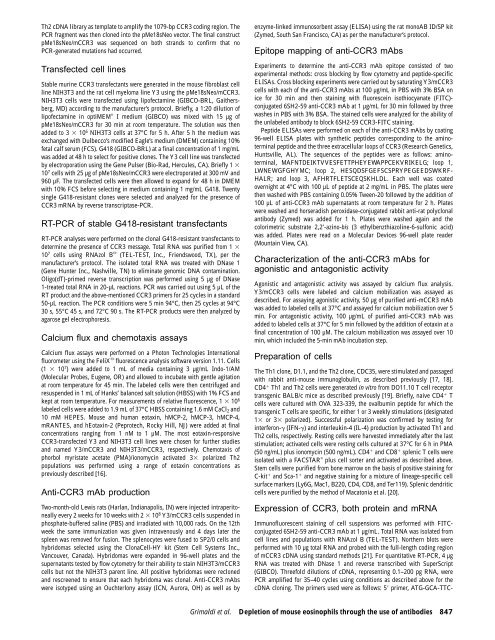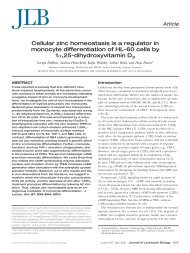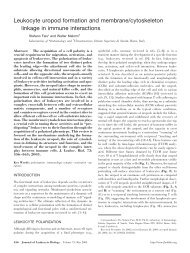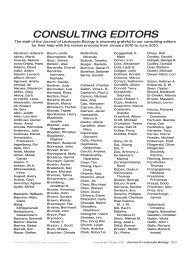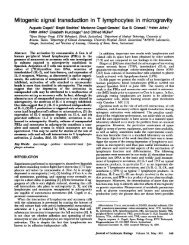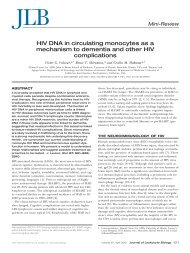Depletion of eosinophils in mice through the use - Journal of ...
Depletion of eosinophils in mice through the use - Journal of ...
Depletion of eosinophils in mice through the use - Journal of ...
Create successful ePaper yourself
Turn your PDF publications into a flip-book with our unique Google optimized e-Paper software.
Th2 cDNA library as template to amplify <strong>the</strong> 1079-bp CCR3 cod<strong>in</strong>g region. The<br />
PCR fragment was <strong>the</strong>n cloned <strong>in</strong>to <strong>the</strong> pMe18sNeo vector. The f<strong>in</strong>al construct<br />
pMe18sNeo/mCCR3 was sequenced on both strands to confirm that no<br />
PCR-generated mutations had occurred.<br />
Transfected cell l<strong>in</strong>es<br />
Stable mur<strong>in</strong>e CCR3 transfectants were generated <strong>in</strong> <strong>the</strong> mo<strong>use</strong> fibroblast cell<br />
l<strong>in</strong>e NIH3T3 and <strong>the</strong> rat cell myeloma l<strong>in</strong>e Y3 us<strong>in</strong>g <strong>the</strong> pMe18sNeo/mCCR3.<br />
NIH3T3 cells were transfected us<strong>in</strong>g lip<strong>of</strong>ectam<strong>in</strong>e (GIBCO-BRL, Gai<strong>the</strong>rsberg,<br />
MD) accord<strong>in</strong>g to <strong>the</strong> manufacturer’s protocol. Briefly, a 1:20 dilution <strong>of</strong><br />
lip<strong>of</strong>ectam<strong>in</strong>e <strong>in</strong> optiMEM � I medium (GIBCO) was mixed with 15 µg <strong>of</strong><br />
pMe18sNeo/mCCR3 for 30 m<strong>in</strong> at room temperature. The solution was <strong>the</strong>n<br />
added to 3 � 10 6 NIH3T3 cells at 37°C for 5 h. After 5 h <strong>the</strong> medium was<br />
exchanged with Dulbecco’s modified Eagle’s medium (DMEM) conta<strong>in</strong><strong>in</strong>g 10%<br />
fetal calf serum (FCS). G418 (GIBCO-BRL) at a f<strong>in</strong>al concentration <strong>of</strong> 1 mg/mL<br />
was added at 48 h to select for positive clones. The Y3 cell l<strong>in</strong>e was transfected<br />
by electroporation us<strong>in</strong>g <strong>the</strong> Gene Pulser (Bio-Rad, Hercules, CA). Briefly 1 �<br />
10 7 cells with 25 µg <strong>of</strong> pMe18sNeo/mCCR3 were electroporated at 300 mV and<br />
960 µF. The transfected cells were <strong>the</strong>n allowed to expand for 48 h <strong>in</strong> DMEM<br />
with 10% FCS before select<strong>in</strong>g <strong>in</strong> medium conta<strong>in</strong><strong>in</strong>g 1 mg/mL G418. Twenty<br />
s<strong>in</strong>gle G418-resistant clones were selected and analyzed for <strong>the</strong> presence <strong>of</strong><br />
CCR3 mRNA by reverse transcriptase-PCR.<br />
RT-PCR <strong>of</strong> stable G418-resistant transfectants<br />
RT-PCR analyses were performed on <strong>the</strong> clonal G418-resistant transfectants to<br />
determ<strong>in</strong>e <strong>the</strong> presence <strong>of</strong> CCR3 message. Total RNA was purified from 1 �<br />
10 7 cells us<strong>in</strong>g RNAzol B � (TEL-TEST, Inc., Friendswood, TX), per <strong>the</strong><br />
manufacturer’s protocol. The isolated total RNA was treated with DNase 1<br />
(Gene Hunter Inc., Nashville, TN) to elim<strong>in</strong>ate genomic DNA contam<strong>in</strong>ation.<br />
Oligo(dT)-primed reverse transcription was performed us<strong>in</strong>g 5 µg <strong>of</strong> DNase<br />
1-treated total RNA <strong>in</strong> 20-µL reactions. PCR was carried out us<strong>in</strong>g 5 µL <strong>of</strong> <strong>the</strong><br />
RT product and <strong>the</strong> above-mentioned CCR3 primers for 25 cycles <strong>in</strong> a standard<br />
50-µL reaction. The PCR conditions were 5 m<strong>in</strong> 94°C, <strong>the</strong>n 25 cycles at 94°C<br />
30 s, 55°C 45 s, and 72°C 90 s. The RT-PCR products were <strong>the</strong>n analyzed by<br />
agarose gel electrophoresis.<br />
Calcium flux and chemotaxis assays<br />
Calcium flux assays were performed on a Photon Technologies International<br />
fluorometer us<strong>in</strong>g <strong>the</strong> FeliX � fluorescence analysis s<strong>of</strong>tware version 1.11. Cells<br />
(1 � 10 7 ) were added to 1 mL <strong>of</strong> media conta<strong>in</strong><strong>in</strong>g 3 µg/mL Indo-1/AM<br />
(Molecular Probes, Eugene, OR) and allowed to <strong>in</strong>cubate with gentle agitation<br />
at room temperature for 45 m<strong>in</strong>. The labeled cells were <strong>the</strong>n centrifuged and<br />
resuspended <strong>in</strong> 1 mL <strong>of</strong> Hanks’ balanced salt solution (HBSS) with 1% FCS and<br />
kept at room temperature. For measurements <strong>of</strong> relative fluorescence, 1 � 10 6<br />
labeled cells were added to 1.9 mL <strong>of</strong> 37°C HBSS conta<strong>in</strong><strong>in</strong>g 1.6 mM CaCl2 and<br />
10 mM HEPES. Mo<strong>use</strong> and human eotax<strong>in</strong>, hMCP-2, hMCP-3, hMCP-4,<br />
mRANTES, and hEotax<strong>in</strong>-2 (Peprotech, Rocky Hill, NJ) were added at f<strong>in</strong>al<br />
concentrations rang<strong>in</strong>g from 1 nM to 1 µM. The most eotax<strong>in</strong>-responsive<br />
CCR3-transfected Y3 and NIH3T3 cell l<strong>in</strong>es were chosen for fur<strong>the</strong>r studies<br />
and named Y3/mCCR3 and NIH3T3/mCCR3, respectively. Chemotaxis <strong>of</strong><br />
phorbol myristate acetate (PMA)/ionomyc<strong>in</strong> activated 3� polarized Th2<br />
populations was performed us<strong>in</strong>g a range <strong>of</strong> eotax<strong>in</strong> concentrations as<br />
previously described [16].<br />
Anti-CCR3 mAb production<br />
Two-month-old Lewis rats (Harlan, Indianapolis, IN) were <strong>in</strong>jected <strong>in</strong>traperitoneally<br />
every 2 weeks for 10 weeks with 2 � 10 8 Y3/mCCR3 cells suspended <strong>in</strong><br />
phosphate-buffered sal<strong>in</strong>e (PBS) and irradiated with 10,000 rads. On <strong>the</strong> 12th<br />
week <strong>the</strong> same immunization was given <strong>in</strong>travenously and 4 days later <strong>the</strong><br />
spleen was removed for fusion. The splenocytes were f<strong>use</strong>d to SP2/0 cells and<br />
hybridomas selected us<strong>in</strong>g <strong>the</strong> ClonaCell-HY kit (Stem Cell Systems Inc.,<br />
Vancouver, Canada). Hybridomas were expanded <strong>in</strong> 96-well plates and <strong>the</strong><br />
supernatants tested by flow cytometry for <strong>the</strong>ir ability to sta<strong>in</strong> NIH3T3/mCCR3<br />
cells but not <strong>the</strong> NIH3T3 parent l<strong>in</strong>e. All positive hybridomas were recloned<br />
and rescreened to ensure that each hybridoma was clonal. Anti-CCR3 mAbs<br />
were isotyped us<strong>in</strong>g an Ouchterlony assay (ICN, Aurora, OH) as well as by<br />
enzyme-l<strong>in</strong>ked immunosorbent assay (ELISA) us<strong>in</strong>g <strong>the</strong> rat monoAB ID/SP kit<br />
(Zymed, South San Francisco, CA) as per <strong>the</strong> manufacturer’s protocol.<br />
Epitope mapp<strong>in</strong>g <strong>of</strong> anti-CCR3 mAbs<br />
Experiments to determ<strong>in</strong>e <strong>the</strong> anti-CCR3 mAb epitope consisted <strong>of</strong> two<br />
experimental methods: cross block<strong>in</strong>g by flow cytometry and peptide-specific<br />
ELISAs. Cross block<strong>in</strong>g experiments were carried out by saturat<strong>in</strong>g Y3/mCCR3<br />
cells with each <strong>of</strong> <strong>the</strong> anti-CCR3 mAbs at 100 µg/mL <strong>in</strong> PBS with 3% BSA on<br />
ice for 30 m<strong>in</strong> and <strong>the</strong>n sta<strong>in</strong><strong>in</strong>g with fluoresce<strong>in</strong> isothiocyanate (FITC)conjugated<br />
6SH2-59 anti-CCR3 mAb at 1 µg/mL for 30 m<strong>in</strong> followed by three<br />
washes <strong>in</strong> PBS with 3% BSA. The sta<strong>in</strong>ed cells were analyzed for <strong>the</strong> ability <strong>of</strong><br />
<strong>the</strong> unlabeled antibody to block 6SH2-59 CCR3-FITC sta<strong>in</strong><strong>in</strong>g.<br />
Peptide ELISAs were performed on each <strong>of</strong> <strong>the</strong> anti-CCR3 mAbs by coat<strong>in</strong>g<br />
96-well ELISA plates with syn<strong>the</strong>tic peptides correspond<strong>in</strong>g to <strong>the</strong> am<strong>in</strong>oterm<strong>in</strong>al<br />
peptide and <strong>the</strong> three extracellular loops <strong>of</strong> CCR3 (Research Genetics,<br />
Huntsville, AL). The sequences <strong>of</strong> <strong>the</strong> peptides were as follows: am<strong>in</strong>oterm<strong>in</strong>al,<br />
MAFNTDEIKTVVESFETTPHEYEWAPPCEKVRIKELG; loop 1,<br />
LWNEWGFGHYMC; loop 2, HESQDSFGEFSCSPRYPEGEEDSWKRF-<br />
HALR; and loop 3, AFHRTFLETSCEQSKHLDL. Each well was coated<br />
overnight at 4°C with 100 µL <strong>of</strong> peptide at 2 mg/mL <strong>in</strong> PBS. The plates were<br />
<strong>the</strong>n washed with PBS conta<strong>in</strong><strong>in</strong>g 0.05% Tween-20 followed by <strong>the</strong> addition <strong>of</strong><br />
100 µL <strong>of</strong> anti-CCR3 mAb supernatants at room temperature for 2 h. Plates<br />
were washed and horseradish peroxidase-conjugated rabbit anti-rat polyclonal<br />
antibody (Zymed) was added for 1 h. Plates were washed aga<strong>in</strong> and <strong>the</strong><br />
colorimetric substrate 2,2’-az<strong>in</strong>o-bis (3 ethylbenzthiazol<strong>in</strong>e-6-sulfonic acid)<br />
was added. Plates were read on a Molecular Devices 96-well plate reader<br />
(Mounta<strong>in</strong> View, CA).<br />
Characterization <strong>of</strong> <strong>the</strong> anti-CCR3 mAbs for<br />
agonistic and antagonistic activity<br />
Agonistic and antagonistic activity was assayed by calcium flux analysis.<br />
Y3/mCCR3 cells were labeled and calcium mobilization was assayed as<br />
described. For assay<strong>in</strong>g agonistic activity, 50 µg <strong>of</strong> purified anti-mCCR3 mAb<br />
was added to labeled cells at 37°C and assayed for calcium mobilization over 5<br />
m<strong>in</strong>. For antagonistic activity, 100 µg/mL <strong>of</strong> purified anti-CCR3 mAb was<br />
added to labeled cells at 37°C for 5 m<strong>in</strong> followed by <strong>the</strong> addition <strong>of</strong> eotax<strong>in</strong> at a<br />
f<strong>in</strong>al concentration <strong>of</strong> 100 µM. The calcium mobilization was assayed over 10<br />
m<strong>in</strong>, which <strong>in</strong>cluded <strong>the</strong> 5-m<strong>in</strong> mAb <strong>in</strong>cubation step.<br />
Preparation <strong>of</strong> cells<br />
The Th1 clone, D1.1, and <strong>the</strong> Th2 clone, CDC35, were stimulated and passaged<br />
with rabbit anti-mo<strong>use</strong> immunoglobul<strong>in</strong>, as described previously [17, 18].<br />
CD4 � Th1 and Th2 cells were generated <strong>in</strong> vitro from DO11.10 T cell receptor<br />
transgenic BALB/c <strong>mice</strong> as described previously [19]. Briefly, naive CD4 � T<br />
cells were cultured with OVA 323-339, <strong>the</strong> ovalbum<strong>in</strong> peptide for which <strong>the</strong><br />
transgenic T cells are specific, for ei<strong>the</strong>r 1 or 3 weekly stimulations (designated<br />
1� or 3� polarized). Successful polarization was confirmed by test<strong>in</strong>g for<br />
<strong>in</strong>terferon-� (IFN-�) and <strong>in</strong>terleuk<strong>in</strong>-4 (IL-4) production by activated Th1 and<br />
Th2 cells, respectively. Rest<strong>in</strong>g cells were harvested immediately after <strong>the</strong> last<br />
stimulation; activated cells were rest<strong>in</strong>g cells cultured at 37°C for 6h<strong>in</strong>PMA<br />
(50 ng/mL) plus ionomyc<strong>in</strong> (500 ng/mL). CD4 � and CD8 � splenic T cells were<br />
isolated with a FACSTAR � plus cell sorter and activated as described above.<br />
Stem cells were purified from bone marrow on <strong>the</strong> basis <strong>of</strong> positive sta<strong>in</strong><strong>in</strong>g for<br />
C-kit � and Sca-1 � and negative sta<strong>in</strong><strong>in</strong>g for a mixture <strong>of</strong> l<strong>in</strong>eage-specific cell<br />
surface markers (Ly6G, Mac1, B220, CD4, CD8, and Ter119). Splenic dendritic<br />
cells were purified by <strong>the</strong> method <strong>of</strong> Macatonia et al. [20].<br />
Expression <strong>of</strong> CCR3, both prote<strong>in</strong> and mRNA<br />
Immun<strong>of</strong>luorescent sta<strong>in</strong><strong>in</strong>g <strong>of</strong> cell suspensions was performed with FITCconjugated<br />
6SH2-59 anti-CCR3 mAb at 1 µg/mL. Total RNA was isolated from<br />
cell l<strong>in</strong>es and populations with RNAzol B (TEL-TEST). Nor<strong>the</strong>rn blots were<br />
performed with 10 µg total RNA and probed with <strong>the</strong> full-length cod<strong>in</strong>g region<br />
<strong>of</strong> mCCR3 cDNA us<strong>in</strong>g standard methods [21]. For quantitative RT-PCR, 4 µg<br />
RNA was treated with DNase 1 and reverse transcribed with SuperScript<br />
(GIBCO). Threefold dilutions <strong>of</strong> cDNA, represent<strong>in</strong>g 0.1–200 pg RNA, were<br />
PCR amplified for 35–40 cycles us<strong>in</strong>g conditions as described above for <strong>the</strong><br />
cDNA clon<strong>in</strong>g. The primers <strong>use</strong>d were as follows: 5� primer, ATG-GCA-TTC-<br />
Grimaldi et al. <strong>Depletion</strong> <strong>of</strong> mo<strong>use</strong> <strong>eos<strong>in</strong>ophils</strong> <strong>through</strong> <strong>the</strong> <strong>use</strong> <strong>of</strong> antibodies 847


